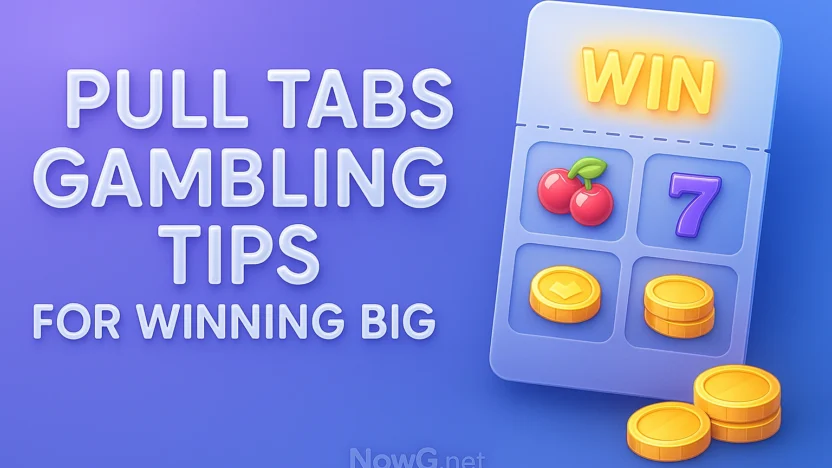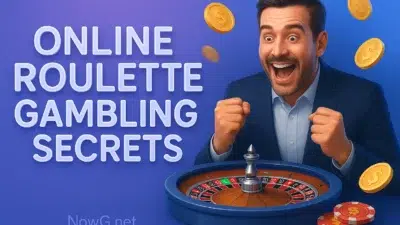Last Updated on August 31, 2025 by Caesar Fikson
Ready to find out the secrets behind pulling big wins in pull tab gambling? Today, you’ll learn everything new about these games. Discover how cheaper tickets can offer better chances to win and how selling many pull tab tickets can significantly increase your profits.

Did you know some lower-priced pull-tab tickets have great odds of winning? It’s a fact! Play smartly and win often without spending big.
Pull tabs look simple—tear, reveal, cheer (or groan). But behind those little cardboard windows sits real math, predictable structures, and a few repeatable edges that separate lucky nights from disciplined sessions. You can’t “beat” a fair game forever, but you can absolutely play smarter, hunt positive expected value (EV), and dodge the traps that drain casual players.
Below is the full playbook: how deals work, how to read payout sheets, when to pounce, when to walk, bankroll control, venue tactics, machine vs. paper differences, and—because it comes up—how sellers maximize fundraising without burning player goodwill. No fluff, no myths.
What You’re Actually Buying
A pull tab deal (also called a box or set) is a preprinted batch with:
- A fixed number of tickets (e.g., 1, 2, or 4 thousand).
- A fixed prize table (how many wins of each size).
- A printed payout sheet/flyer that tells you the total prize money in that deal.
Once a deal ships, the odds don’t change. What changes—and where your edge lives—is what’s left vs what’s already hit.
The Single Most Important Move: The 10-Second EV Check
You’re not guessing—you’re estimating.
EV per ticket = (Total value of remaining prizes) ÷ (Number of remaining tickets)
If EV > ticket price, that deal is (mathematically) worth playing right now. If EV is close to or below the price, it’s a slow bleed—unless you value the entertainment enough to accept it.
Real-world snag: you rarely know the exact remainder. So you approximate from the winner board, staff tallies, and how full the box looks.
Fast example
- Ticket price: $1
- Tickets left (estimate): ~200
- Prizes confirmed unclaimed: one $100, two $20s, six $5s = $100 + $40 + $30 = $170
- EV ≈ $170 ÷ 200 = $0.85 → below price. Skip.
If the $100 hasn’t hit and there are only ~120 left, EV jumps to ≈ $1.42 → now it’s interesting.
The Late-Box Advantage
Every deal starts neutral. The only time the math tilts toward you is when:
- Big prizes remain, and
- Ticket count is low.
That’s why seasoned players “sweep” near closing or after a rush. The last 10–20% of a deal can be the best shots you’ll see all night.
Strategy Cheat Sheet
| Signal | What It Means | Action |
|---|---|---|
| Few tickets left, top prize not claimed | Rising EV, fewer duds | Buy in a block; don’t drip. |
| Staff tracks winners on a board | You can estimate remainder accurately | Run the EV check. |
| “Last sale” bonus posted | End of deal pays an extra $20–$100+ | If <20 tickets left, that bonus alone can make it +EV. |
| Mixed box (leftovers combined) | Unknown composition | Hard pass—no math, no edge. |
| Fresh deal, huge headline prize | High variance, usually lower EV early | Sample lightly or skip until later. |
| Lower-priced games with many mediums | Smoother variance | Good for longer sessions and bankroll control. |
The Classic 10 Tips—Upgraded With Real Tactics
1) Know the rules and prize map
Don’t buy blind. Get the payout sheet (how many tickets total, how many winners by tier). If there’s no sheet or board, your EV estimate is guesswork.
2) Buy multiple from the same deal (when the math says so)
Once a deal looks favorable, buy in clumps. Buying one at a time while the box is hot just invites someone else to snipe the remainder you inflated.
3) Observe before you act
Watch a few cycles. If small and medium prizes have been hitting but no top yet, EV may be building. If the top has popped and the board shows many mediums gone too, move on.
4) Budget and session rules
Have a hard stop-loss (e.g., 3–5% of your weekly entertainment budget) and a stop-win (e.g., 1–2× buy-in). Positive EV still whipsaws; protect gains and your mood.
5) Don’t misread your tickets
Organize by game, double-check winners, and redeem promptly. Some houses post claim windows. Leave late, lose late.
6) Start small, then scale
New to a venue? Use lower-priced tickets to map how they track winners and how fast deals churn. Scale your spend only when you can estimate.
7) Venue selection matters
Some rooms rotate deals faster, update boards faithfully, and post last-sale bonuses. That transparency is part of your edge.
8) Don’t chase
Cold run? Switch deals, not judgment. Gambler’s fallacy is the tax you pay for ignoring math.
9) Track results
Keep a simple log: date, venue, game, tickets bought, known remaining top/medium prizes, net. Patterns appear fast: which games, which times, which rooms.
10) Remember the point
Play for entertainment; hunt edges when they appear; leave when they don’t. If it stops being fun, you’re done for the night.
Odds, Payouts, and Choosing the Right Game
Think of games along two axes: hit frequency and payout concentration.
- High frequency, lower top prize → more steady beeps, fewer heartbreaks.
- Low frequency, big top prize → long deserts, big celebration… sometimes followed by regret.
Example Comparison
| Game | Tickets per Deal | Ticket Price | Top Prize | Count of Top Prizes | Overall Hit Rate | Notes |
|---|---|---|---|---|---|---|
| A | 1,000 | $1 | $500 | 1 | 1 in 12 | Lots of small/mediums; good for session length. |
| B | 500 | $2 | $1,000 | 1 | 1 in 20 | Punchier swings; better for late-box hunting. |
| C | 2,000 | $1 | $100 | 8 | 1 in 10 | Smoother variance; fewer droughts. |
Pick C for learning and long sessions, B for surgical late-box attacks, A when the room posts running winner counts and you can estimate remainder precisely.
EV Scenarios You’ll Actually See
| Situation | Remaining Tickets | Unclaimed Prizes | Ticket Price | EV Math | Verdict |
|---|---|---|---|---|---|
| Fresh box, eye-popping jackpot | ~100% | All prizes | $1 | EV ≈ (Total payout ÷ total tickets). Usually < $1 | Sample small at most. |
| Halfway sold, top untouched | ~50% | $500 + a few $20s/$5s | $1 | EV rises as ticket count falls | Worth probing; buy in clumps. |
| 20 tickets left, top still there, last-sale bonus $50 | 20 | $500 + $50 bonus | $1 | EV ≈ ($550 ÷ 20) = $27.50 pre-probability | Snap buy if budget allows. |
| Near empty, board shows top prize already hit | <10% | Only crumbs | $1 | EV collapses | Walk. |
Note: EV assumes perfect knowledge, which you rarely have. That’s why the board and staff tracking matter.
Bankroll, Risk, and Session Planning
| Bankroll | Suggested Buy-in per Box | Stop-Loss | Stop-Win | Rationale |
|---|---|---|---|---|
| $50 | $10–$15 | $25 | Double up or +$20 | You’re mapping: cheap tickets, low pain. |
| $200 | $40–$60 | $100 | +$100 | Enough to capitalize on one strong late box. |
| $500 | $100–$150 | $200 | +$200–$300 | Lets you block-buy when EV spikes. |
Kelly-ish thought: Pull tabs are lumpy; if you think you’ve found a positive EV, still fractionalize your aggression. Spread risk across a few favorable boxes rather than all-in on one.
Venue Tactics That Quietly Matter
- Time your visit. Late evenings often reveal low-ticket boxes with unclaimed tops.
- Favor transparency. Houses that post winner counts and last-sale bonuses are your friends.
- Be polite with staff. They’re the gatekeepers of info (and may tell you when a fresh top just hit so you don’t torch your roll).
- Tag-team with a friend. One watches boards and counts tickets; the other buys when EV turns. Don’t block other players—etiquette matters.
Machine Pull Tabs vs. Paper
Machines (electronic pull tabs) often display tickets remaining and sometimes remaining top prizes. That’s a math gift—use it.
Pros
- Fast cycles → more opportunities to find edges.
- Clear remaining count.
Cons
- Competition can be fierce; edges vanish quickly.
- House settings govern payout curves—don’t assume transparency beyond what’s displayed.
Tactic: If a machine shows remaining count and the top hasn’t hit, watch for thresholds (e.g., top prize still there below 10% remaining). Act decisively.
Myths vs. Reality
| Claim | Reality | What To Do |
|---|---|---|
| “This box is hot.” | No. That’s variance talking. | Math > vibes. Check the board. |
| “Buy one from every game to spread luck.” | You destroy your ability to estimate remainder. | Stick to one promising deal. |
| “Bigger jackpots mean better odds.” | Usually the opposite. | Pick based on remaining EV, not headline size. |
| “If I just keep buying, it’ll hit.” | Maybe—for the next person. | Set stop-loss/stop-win rules and honor them. |
Advanced Edges (When You’re Ready)
- Shadow the churn. The best rooms cycle deals quickly and update boards meticulously. Track which games turn over nightly; those give you more late-box windows.
- Last-sale hunting. Many bars/charities pay a bonus for the final ticket. If ~10–20 remain and the bonus is material, EV can flip positive even if the top prize is gone.
- Medium-prize bias. Deals with more $20–$100 hits protect bankroll while you wait for a shot at the top. Quietly powerful.
- Syndicate without being a jerk. Two people pooling for a late box can lock EV before the room notices. Keep it polite; don’t hoard multiple boxes or crowd staff.
- Switch after a top hit. If the top pops early and the board shows mediums drying up, move your focus. Don’t try to “win it back” in a dead deal.
Responsible Play (The Part That Saves Futures)
- Only use entertainment money.
- Keep a log (spend, wins, net) so “it felt good” doesn’t overwrite reality.
- Take breaks every hour. You think better when you’re not adrenaline-blind.
- If you feel compulsion creeping in, walk. Pull tabs will still be there next week.
For Organizers and Sellers
Players care about fairness, clarity, and fun. You care about margin and compliance. Those aren’t in conflict if you design well.
| Lever | Why It Works | Best Practices |
|---|---|---|
| Transparent winner boards 🧮 | Players can estimate; trust rises; sales increase | Post remaining tops and mediums; update promptly |
| Last-sale bonuses 🎯 | Drives deal completion; prevents “dead” boxes | Make it visible; pay instantly; celebrate the closer |
| Mix of price points 💵 | Broadens participation; increases dwell time | Offer $1 and $2 games with different variance profiles |
| Machine + paper hybrids 🎛️ | Different players, different habits | Place machines in sightlines; paper at bars/tables |
| Cause storytelling ❤️ | Pull tabs are often charity-linked | Post monthly impact summaries; thank winners & donors |
Short version: clarity sells. The more your players can see, the more they’ll play—happily.
Quick Win Table (Bookmark This)
| Situation | Edge Signal | Your Move | Risk Control |
|---|---|---|---|
| Box ~90% sold, top unclaimed 🟢 | Board confirms “top: 0 claimed” | Buy 10–20 at once | Stop after top/medium hits or stop-loss |
| Box ~50% sold, multiple mediums unclaimed 🟡 | Frequent $20–$50 still live | Probe with 5–10; reassess | Tighten stop-loss |
| Fresh box 🔴 | Nothing known yet | Sample 1–3 or skip | Save ammo for late windows |
| Mixed leftovers 🚫 | No math possible | Avoid | N/A |
| Last ticket bonus posted 🟢 | $20–$100+ final ticket | If <20 remain, consider clearing | Watch budget; variance spikes near end |
A Note on Legality and House Rules
Pull tabs gambling are jurisdiction-specific. Venues follow licensing and payout rules; many are charity-linked. Know the local rules, respect venue policies, and never pressure staff for info they can’t share.
If You Only Remember Three Things
- Late boxes with big prizes unclaimed are your best friend.
- EV > ticket price or you’re paying for entertainment—own that choice.
- Stop-loss / stop-win rules keep good nights good and bad nights small.
Conclusion
Selling more than one set of tickets can massively boost what you earn. You see massive potential by just doing simple math on the ticket prices and amounts. Think of the profit it could bring!
When you pull out the winning combination – pull tabs gambling can be rewarding in more ways than one. They can help raise money for important causes. Follow this advice to have a great time with pull tabs and possibly win big. Stay informed, be smart with your money, and use every chance to improve your odds.
Play smart. Play politely. Play responsibly. Remember it’s not only about break opens and winning symbols.
And when the board lines up and the math sings—buy in a clump, check twice, and enjoy the rip.
FAQ
How do pull tabs gambling work?
Pull tabs are like scratch cards you buy for a chance to win. The games vary in prizes, how often you win, and cost. You see if you won immediately when you buy a pull tab ticket
How can I calculate the profit from selling pull tab tickets?
To find the profit from selling pull tabs, multiply the ticket price by the total number of tickets.
How can I determine the odds and prize amounts of pull tab games?
You can determine pull tabs’ odds and prizes by looking at what the supplier gives you. You can also find out by totaling the prizes for each game.
Are there different ways to play pull tab games?
You can play by putting money into machines that give you tickets. These machines show how many tickets are left. Pull tabs are also used for charity, where the money goes to a good cause.
How can I choose a suitable pull tab game?
Picking the best pull tab game involves looking at the cost, prize amounts, and your chances of winning. Studying the odds and prizes helps select the game with the best chances to win.
Are there any tips for winning big in pull tab gambling?
Learn about the games’ odds and prizes for a better chance at winning. Have a budget and stick to it. Buy more tickets to boost your winning chances. Pull tab machines are easy to use. Also, playing in fundraisers can help win big and support a cause.
What makes pull tabs gambling exciting?
Pull tabs offer a fast way to win large prizes possibly. With many games, players enjoy the rush of winning instantly and the chance to win substantial awards.
How to win at pull tabs?
You can’t—pull tabs are pure chance—but buying in bulk, playing higher-payout games, and checking prize boards can slightly improve your odds.
How to win at electronic pull tabs?
You can’t really “beat” electronic pull tabs — they’re just like slots: fully random, run on RNGs, and programmed with a set payout percentage that favors the house.
How to play pull tabs?
Buy a ticket, pull open the perforated tabs, match symbols—winning combos pay out instantly.
What’s the best pull tabs strategy?
There’s no true winning strategy—pull tabs are pure luck. The best you can do:
* Buy early from a fresh box (big prizes usually go fast).
* Ask if jackpots are still unclaimed before playing.
* Stick to higher-priced tickets; they usually have better payouts.
* Set a budget and walk away if you hit a decent win.





[…] Bars & fraternal clubs – still the heartland of “bar pull tabs.” […]